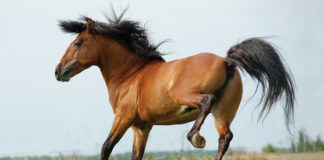If you are considering pulling your horse’s shoes and trying the barefoot approach, it’s important to educate yourself on this method of horse-keeping. Your farrier, and your horse’s daily care and diet, will likely change.

“There are many advantages to keeping a horse barefoot, especially with the findings gleaned from current research on the hoof,” says Kelly Mount, a barefoot trimmer based in Gavalin Hills, Calif. These benefits include less expense, since a barefoot trim every four weeks is usually cheaper than new shoes every six weeks. Barefoot hooves also have better traction than shod feet, according to Mount, and barefoot provides a more natural and healthier way for the horse’s feet and legs to function.
Hoof boots are a good option for barefoot horses when extra protection is necessary.
“Hoof boots offer horses protection as feet transition out of shoes, if the horse will be working on varied terrain, or if continued support for different pathologies, such as navicular or thin soles, is needed,” says Mount. “Hoof boots help the horse heal without limiting the wonderful flexion of the foot, which is inhibited by shoes.”
Mount notes that even if issues can’t be corrected or healed by the body entirely, boots are a better option than steel because they allow for more flexion, concussive relief, crucial heel-first landings and sole support. All this provides a healthier hoof mechanism while keeping the horse comfortable.
Barefoot Lifestyle
Before you pull your horse’s shoes, it’s important to know that having a healthy barefoot horse means some changes in the way you care for your horse.
Both barefoot and shod horses are at risk of thrush, especially if they are kept in a stall or small paddock. Urine and manure become packed around the frog, resulting in bacterial and fungal growth that eats away at the healthy tissue, often causing soreness or abscesses.
Keeping a horse’s foot free of thrush is especially crucial if the horse is barefoot because he does not have shoes to reduce the hoof’s contact with the ground. A thrushy hoof is a painful hoof, and the pain is more easily felt if the horse is barefoot.
Keeping a stalled horse’s feet clear of thrush means thoroughly picking them out and rinsing them every day with water. A scrub with an idione solution a couple of times a week will also help keep thrush at bay. Horses already affected with thrush will require more work to get rid of the infection, including a daily application of topical fungal and antibiotic ointments.
Diet is another important element when it comes to healthy barefoot hooves. Too much sugar in a horse’s diet can contribute to soft hooves and issues with thrush, according to Mount. In order to have a healthy horse with barefoot hooves, a low-sugar hay and a diet free of sweet feed are paramount.
A Barefoot Trim
If you are willing to provide the kind of daily care and diet that your horse needs to go barefoot, your first step is to find a knowledgeable barefoot farrier. The difference between barefoot and traditional farriers is more than just about shoes; it’s also about the trim. Barefoot farriers apply a trim that mimics the wear of feral horse hooves, with the idea that this is the how the horse’s hoof would wear naturally if the horse were in the wild. Traditional farriers do not apply this “mustang trim,” but instead trim the same way they would if they were going to apply a shoe.
Barefoot advocates recommend a farrier who specializes in barefoot horses and uses a mustang trim. These farriers are also adept in adjusting the trim to help ease leg and hoof issues, such as navicular or clubfoot.
If your horse has never gone barefoot, your farrier may recommend hoof boots to help him make the transition out of shoes.
To locate a barefoot farrier in your area, visit The Horse’s Hoof at www.thehorseshoof.com/trimmers.html.
Liked this article? Here are others on hoof care:
Experts’ Opinions on Keeping a Barefoot Horse
The Barefoot Life
Alternative Hoofwear






Great advice.
All my horses go barefooted, it is the best way, plus natural.
I would like to add that in my experience a shod hoof collects more mud, dirt, and stones than a bare foot, thus increasing the incidence of thrush.